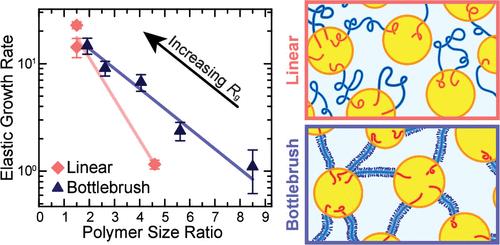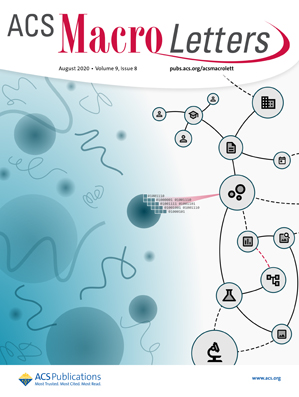底层中间块促进远缘聚合物的胶体桥接
IF 5.2
Q1 POLYMER SCIENCE
引用次数: 0
摘要
远切聚合物是一种有效的流变改性剂,可在关联成分之间架桥,形成弹性网络。然而,线性远志链的性能受熵力控制,因此在桥接形成方面存在上限。这项研究利用含有底层中间嵌段的远缘三嵌段共聚物克服了这一限制。通过比较由远缘链底丛聚合物连接的乳液与含有线性链的乳液的流变特性,我们确定了含有底丛中嵌段的远缘链聚合物能更有效地形成弹性网络。这些增强的流变特性源于底丛中块的高硬度,它抵消了形成桥的熵拉伸惩罚,使它们更容易形成网络。这种对复杂流体中聚合物构象的分子级控制,为使用最少的聚合物添加剂设计高弹性网络开辟了道路。本文章由计算机程序翻译,如有差异,请以英文原文为准。

Bottlebrush Midblocks Promote Colloidal Bridging of Telechelic Polymers
Telechelic polymers are effective rheological modifiers that bridge between associative constituents to form elastic networks. The performance of linear telechelic chains, however, is controlled by entropic forces and thus suffers from an upper limit on bridge formation. This work overcomes this limitation by utilizing telechelic triblock copolymers containing bottlebrush midblocks. By comparing the rheological properties of emulsions linked by telechelic bottlebrush polymers to those containing linear chains, we determined that telechelic polymers with bottlebrush midblocks form elastic networks more efficiently. These enhanced rheological properties arise from the high stiffness of the bottlebrush midblocks, which offsets the entropic stretching penalty for bridge formation, enabling them to more readily form networks. This molecular-level control over polymer conformation in complex fluids opens avenues for designing highly elastic networks with minimal polymeric additives.
求助全文
通过发布文献求助,成功后即可免费获取论文全文。
去求助
来源期刊
CiteScore
10.40
自引率
3.40%
发文量
209
审稿时长
1 months
期刊介绍:
ACS Macro Letters publishes research in all areas of contemporary soft matter science in which macromolecules play a key role, including nanotechnology, self-assembly, supramolecular chemistry, biomaterials, energy generation and storage, and renewable/sustainable materials. Submissions to ACS Macro Letters should justify clearly the rapid disclosure of the key elements of the study. The scope of the journal includes high-impact research of broad interest in all areas of polymer science and engineering, including cross-disciplinary research that interfaces with polymer science.
With the launch of ACS Macro Letters, all Communications that were formerly published in Macromolecules and Biomacromolecules will be published as Letters in ACS Macro Letters.

 求助内容:
求助内容: 应助结果提醒方式:
应助结果提醒方式:


